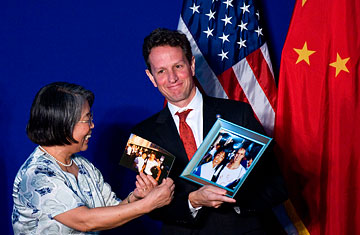
Treasury Secretary Timothy Geithner, in Beijing on June 1, 2009, holds a photo that was taken while he was a student at Beijing University. It was given to him by his former teacher Bo Min, left
As light as this moment was, it served to underscore a point Geithner will make many times on this trip and any other time he comes to Asia in his new job: this is the region of the world, more than any other, that helped shape Geithner's worldview. His father Peter was a senior executive running Asia programs for the Ford Foundation, and as a boy Geithner lived in India and Thailand. In college he studied both Mandarin and Japanese, and as he told the students this morning, his two summers in Beijing (he came after his junior year as well) helped convince him that "I wanted to work for my government, and help to shape its policy toward this part of the world." (See pictures of China's electronic-waste village.)
By the early 1990s, Geithner was deputy Treasury attaché in the Tokyo embassy. Barely 30, he played an outsize role in key trade negotiations for someone so young. By the late '90s, he was in Washington, helping both Lawrence Summers, now President Obama's chief economic adviser, and then Treasury Secretary Robert Rubin deal with the Asian financial crisis that flattened economies in the region.
The depth of his Asia experience and the sense that he understands the concerns of policymakers on this side of the Pacific are now of paramount importance. Chinese leaders have expressed deep concerns about the Obama Administration's efforts to shore up companies and the economy with massive government spending programs, and it is up to Geithner to provide assurances that the value of China's vast holdings of U.S. bonds will not be debased as a result of America's rising deficits. Indeed, a question Geithner heard from a bright young Peking University student is the same one he'll hear on Tuesday, when he is scheduled to meet with Chinese President Hu Jintao and Prime Minister Wen Jiabao: How safe are Chinese investments in U.S. Treasury debt?
"Very safe," Geithner quickly reassured the student questioner, as the audience laughed. Despite the surge in spending to deal with the financial crisis, the Obama Administration is committed to getting the fiscal deficit back down to a level that "is sustainable over the medium term," Geithner said.
The students didn't press him this morning on how, exactly, the U.S. will do that, or what "the medium term" means. That's what the Chinese leadership wants to know, though, and they no doubt started asking later in the day, when Geithner met with Vice Premier Wang Qishan and Zhou Xiaochuan, the governor of the China's central bank.
Establishing yourself as an old friend, as Geithner did this morning, is always good for street cred in China. In these treacherous economic times, though, having persuasive, detailed answers will be even better.
